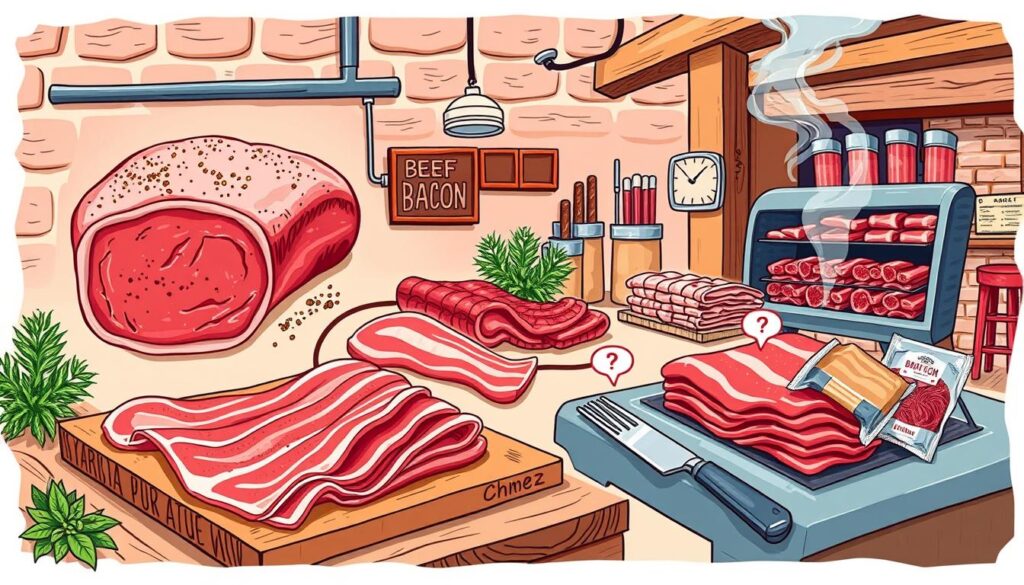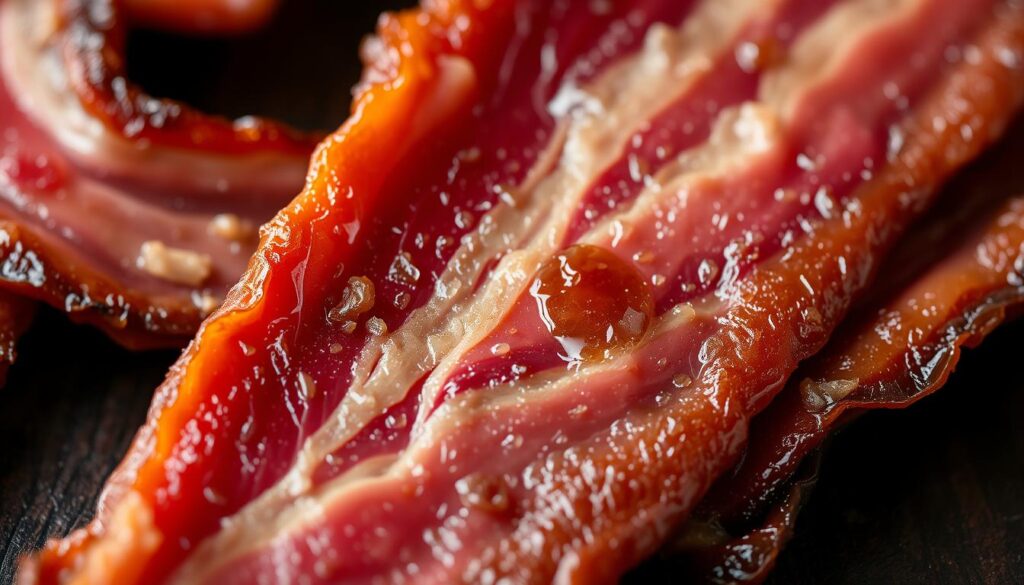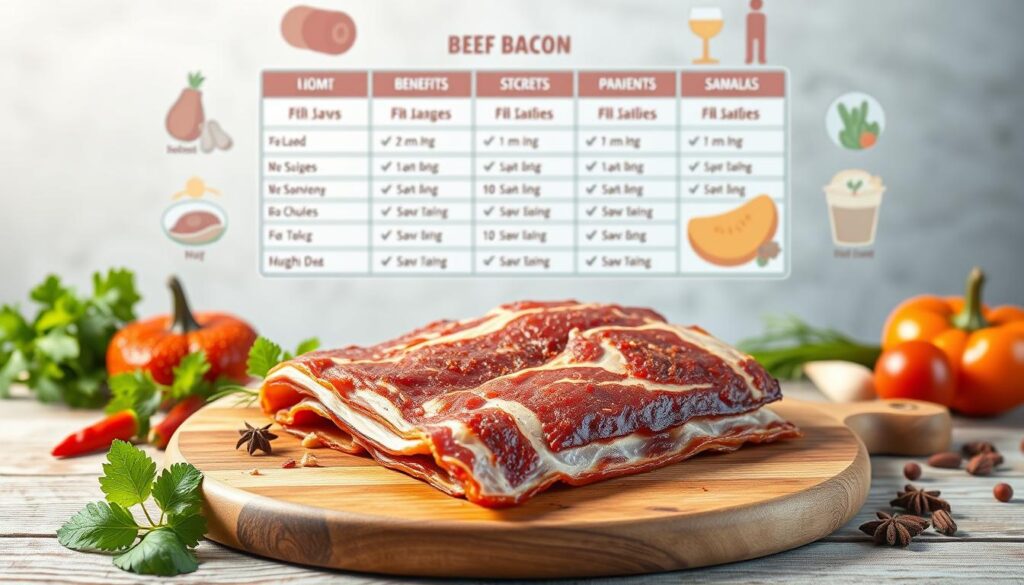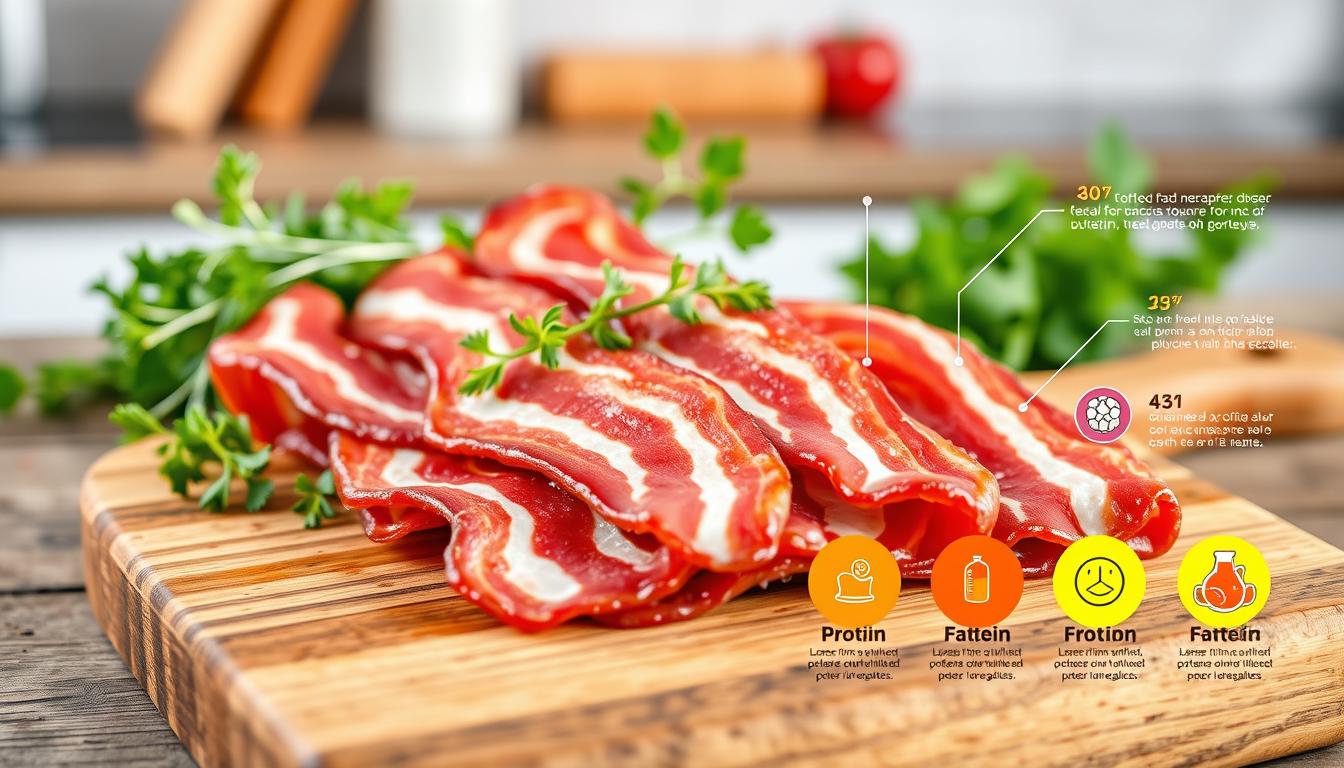Is Beef Bacon Healthy? Every morning, I used to crave that sizzling sound of bacon in the pan. But as a health-conscious foodie, I began exploring alternatives. I wanted something that could satisfy my taste buds while supporting my wellness goals. That’s when I discovered beef bacon – a game-changing protein option that challenges traditional breakfast norms.
Beef bacon health isn’t just a trendy topic; it’s a nutritional revelation waiting to be explored. Unlike its pork counterpart, beef bacon offers a unique profile that might surprise you. The nutritional benefits of beef bacon extend beyond simple flavor, providing a protein-packed alternative that’s catching the attention of health enthusiasts nationwide.
Imagine a bacon that’s not just delicious but potentially more nutritious. With approximately 2.6 grams of protein per slice and only 48.7 calories, beef bacon presents an intriguing option for those seeking a mindful protein source. Its carefully crafted production process ensures a product that’s both flavorful and potentially beneficial to your diet.
Key Takeaways
- Beef bacon offers a unique nutritional profile with higher protein content
- Lower in calories compared to traditional pork bacon
- Made from cattle belly, similar to traditional bacon preparation
- Provides an alternative for those seeking different meat options
- Potential health-conscious choice for breakfast and recipe variations
Understanding Beef Bacon: A Unique Alternative to Pork
Beef bacon is a new twist on traditional bacon. It’s made from a special cut of beef, offering a unique taste and texture. This makes it stand out from regular bacon.

The journey of beef bacon starts with a specific part of the cow’s belly. This area, called the navel section, has layers of fat and meat. These layers give beef bacon its distinct flavor.
What Makes Beef Bacon Distinctive
Beef bacon is different from pork bacon in many ways. It has:
- More monounsaturated fat
- Possibly less hormone exposure
- Unique marbling that adds to its taste
Crafting Beef Bacon from Cattle Belly
The making of beef bacon starts with a special cut from the short plate. Wagyu beef bacon is known for its top-notch quality and bold flavor.
| Production Characteristic | Beef Bacon Details |
|---|---|
| Primary Cut | Cattle Belly (Navel) |
| Fat Composition | High in Monounsaturated Fats |
| Typical Marbling | Extensive Intramuscular Fat |
Curing and Smoking Techniques
Beef bacon is made with care, using special curing methods. Ingredients like Himalayan pink salt and organic sugar add to its gourmet taste. Smoking enhances its rich flavor even more.
« Beef bacon represents more than just an alternative—it’s a culinary experience that transforms traditional breakfast expectations. »
The Distinctive Taste and Texture Profile

Beef bacon is a unique culinary adventure. It offers a rich, bold flavor that changes your breakfast. Unlike pork bacon, it has a meatier texture that will excite your taste buds.
The texture of beef bacon is unlike pork bacon. It’s chewier and has a more substantial bite, like thinly sliced smoked beef brisket. It may not crisp up like pork bacon, but it’s just as satisfying to eat.
Flavor Characteristics
- Rich, bold beef-forward taste
- Less fatty than traditional bacon
- Deeper, more intense meat flavor
- Smoky undertones from curing process
Cooking beef bacon needs some technique tweaks. It won’t crisp up like pork bacon, but it works well in most recipes. Chefs and home cooks alike appreciate its versatility and distinctive profile.
« Beef bacon is like the sophisticated cousin of traditional bacon – more complex, more flavorful. » – Culinary Expert
Beef bacon brings a new level of bacon enjoyment. It’s perfect for those looking for a healthier option or wanting to try something new. Beef bacon offers a delightful taste experience.
Nutritional Composition of Beef Bacon
Knowing what’s in beef bacon is key for good eating choices. Let’s look at the main nutrients that make it a great protein source.
Protein Power in Beef Bacon
Beef bacon is packed with protein. It has about 20 grams of protein for every 100 grams. This makes it a top choice for protein in your diet. The protein in beef bacon helps build muscles and keeps your body working right.
- High protein density
- Essential amino acid profile
- Supports muscle health
Fat Content Analysis
Beef bacon has 30% to 40% fat, depending on the cut. While it might seem like a lot, not all fats are bad. About half of the fat is monounsaturated, which is good for your heart if eaten in the right amounts.

Vitamin and Mineral Profile
Beef bacon is more than just protein and fat. It also has important nutrients for your health. Trace minerals and vitamins like selenium, niacin, and a bit of vitamin B12 are found in beef bacon.
| Nutrient | Amount per 100g |
|---|---|
| Protein | 20g |
| Total Fat | 30-40g |
| Sodium | 1000mg |
| Selenium | Trace amounts |
Nutrition is about balance. Enjoy beef bacon as part of a varied, healthy diet.
Beef bacon has its benefits, but eat it in moderation. Experts say to limit processed meat to two servings a week for the best health.
Is Beef Bacon Healthy? A Detailed Analysis
Beef bacon is tasty, but we need to look at its health side too. It’s important to know what’s in it and how it might affect our health.
« Moderation is key when incorporating beef bacon into a balanced diet. » – Nutrition Experts
Let’s dive into what beef bacon’s nutritional breakdown tells us:
- High protein content: Provides approximately 12g of protein per serving
- Significant sodium levels: Contains 579mg per 3 slices
- Low carbohydrate profile: Less than 1g per serving
Beef bacon does offer some good stuff. It has important nutrients like selenium and phosphorus. Grass-fed beef bacon might be even better for you than regular bacon.
| Nutrient | Per 3 Slices | % Daily Value |
|---|---|---|
| Calories | 161 | 8% |
| Protein | 12g | 24% |
| Total Fat | 12g | 15% |
| Sodium | 579mg | 25% |
The main health worries about beef bacon are sodium and saturated fat. We should eat less of these. Even though it’s good, eating too much is not healthy.
- Enjoy in moderation
- Choose grass-fed options when possible
- Balance with vegetables and whole grains
When eating beef bacon, think about quality and how much you eat. It’s all about balance in your diet.
Beef Bacon vs. Traditional Pork Bacon: A Comparison
When looking at bacon options, knowing the difference between beef bacon and pork bacon is key. This comparison shows how these two meats have different nutritional values and tastes.
Exploring the debate between beef bacon and pork bacon means looking at their nutrition, health effects, and practical uses.
Nutritional Composition Breakdown
| Characteristic | Beef Bacon | Pork Bacon |
|---|---|---|
| Calories per serving | 160 kcal | 147 kcal |
| Protein | 23.8g | 23.1g |
| Total Fat | 7.2g | 5.3g |
| Saturated Fat | 2.6g | 1.6g |
Health Impact Considerations
When thinking about your health, consider these points:
- Beef bacon is leaner
- Pork bacon has less total fat
- Both are good sources of iron and zinc
Cost and Availability Factors
Cost is a big factor in choosing between beef bacon and pork bacon. Pork bacon is usually cheaper and easier to find. Beef bacon, on the other hand, is pricier and considered a specialty item.
« The choice between beef and pork bacon depends on personal nutritional goals and flavor preferences. »
Your choice should match your nutritional needs, taste, and budget. Beef bacon is a good option for those looking for a healthier alternative with a unique flavor.
Health Benefits of Choosing Beef Bacon
Beef bacon is a nutritious choice compared to traditional pork bacon. It’s packed with protein, offering health benefits that appeal to those who care about their health.
Beef bacon’s nutritional profile is impressive. It has 31.3 grams of protein per 100 grams. This helps maintain and grow muscles better than many other foods.
« Beef bacon provides a nutrient-dense option for those seeking a protein-rich meat alternative. »
- High protein content supporting muscle health
- Lower fat compared to traditional bacon
- Rich in essential nutrients
Beef bacon is also rich in nutrients. Here are some highlights:
| Nutrient | Amount per 100g | % Daily Value |
|---|---|---|
| Protein | 31.3g | 63% |
| Monounsaturated Fat | 16.8g | Beneficial |
| Omega-3 Fatty Acids | 0.33g | Heart Health |
The health advantages of beef bacon go beyond protein. It has heart-healthy fats, including 50% oleic acid. This helps control blood sugar and reduce inflammation.
Beef bacon is also good for those watching their diet. It has very low carbs, just 1.4g per 100g. This makes it great for ketogenic diets and more.
Best Cooking Methods for Beef Bacon
Cooking beef bacon is a fun experience that turns this meat into a crispy, tasty treat. Whether you’re cooking at home or in a professional kitchen, knowing how to cook beef bacon is key. It’s all about using the right techniques to bring out its best flavors.
Let’s look at the top ways to cook beef bacon for perfect results every time:
Oven-Baking Techniques
Oven-baking is a great way to cook beef bacon with little effort. Here’s how to do it:
- Preheat the oven to 375°F (190°C)
- Line a baking sheet with parchment paper
- Arrange beef bacon slices without overlapping
- Bake for 10-15 minutes, flipping halfway through
- Check for desired crispiness and remove from oven
Stovetop Preparation Tips
Pan-frying beef bacon needs careful attention to avoid burning. Here are some tips:
- Use a cold cast-iron skillet or non-stick pan
- Cook on medium heat for 5-7 minutes total
- Flip bacon every 2-3 minutes for even cooking
- Drain excess fat on paper towels
Storage and Handling Guidelines
Storing beef bacon properly keeps it delicious and safe to eat:
- Refrigerate cooked beef bacon in an airtight container
- Consume within 4-5 days
- For longer storage, freeze up to 2 months
- Separate layers with parchment paper when freezing
« Cooking beef bacon is an art that combines technique, timing, and passion for great flavor. » – Culinary Expert
Trying out these cooking methods will improve your beef bacon skills. You’ll enjoy a tasty, protein-rich meal.
Creative Ways to Include Beef Bacon in Your Diet
Beef bacon recipes add a fun twist to cooking, bringing deep flavor and variety to your meals. Whether you love cooking or want to try new protein sources, beef bacon can make simple dishes special.
- Breakfast classics: Pair beef bacon with eggs for a protein-packed morning meal
- Sandwich innovation: Create a unique BLT with crispy beef bacon
- Salad enhancement: Sprinkle crumbled beef bacon as a zesty topper
- Burger upgrade: Mix beef bacon into ground beef for extra flavor
- Vegetable companion: Wrap asparagus or stuff jalapeños with beef bacon
For those looking for cooking tips, here are some recommendations:
| Cooking Method | Temperature | Time |
|---|---|---|
| Pan-Frying | Medium Heat | 3-4 minutes per side |
| Baking | 400°F (200°C) | 12-15 minutes |
| Grilling | Medium-High Heat | 2-3 minutes per side |
Pro tip: When cooking beef bacon, aim for a crispy texture that adds a delightful crunch to any dish.
Beef bacon has 48.7 calories per slice and 2.6 grams of protein. It’s a healthy choice compared to traditional pork bacon. Get creative, try new recipes, and enjoy the savory taste of beef bacon!
Selecting Quality Beef Bacon: What to Look For
Choosing quality beef bacon means looking at a few key things. Knowing what makes top-notch bacon helps you pick the best.
Start by checking labels and packaging for quality beef bacon. Look for important aspects:
Grass-Fed Advantages
Grass-fed beef bacon has big health benefits over regular bacon. It has:
- More omega-3 fatty acids
- More antioxidants
- A better nutrient mix
- Is often raised in sustainable farming ways
Decoding Product Labels
When picking beef bacon, focus on labels and certifications:
| Certification | What It Means |
|---|---|
| USDA Organic | No synthetic hormones, antibiotics, or fake ingredients |
| Grass-Fed | Animals eat only grass |
| Animal Welfare Certified | Meets strict animal care rules |
Quality Indicators
Look for these signs of quality in beef bacon:
- Even fat marbling
- Deep, rich color
- Little processing
- Clear where it comes from
« The best beef bacon comes from the best cows, raised well without grain, hormones, or antibiotics. »
Understanding these tips helps you pick top-quality beef bacon. It meets your health and taste needs.
Conclusion
Beef bacon is a great choice for those looking for a healthy bacon option. It’s packed with protein and has less fat. This makes it a top pick for anyone wanting tasty, healthy meals.
Beef bacon is also super versatile. It can be used in everything from breakfast bowls to salads. It adds flavor and nutrition to your meals. Studies show that eating unprocessed beef can be good for your heart, debunking old myths.
Choosing beef bacon doesn’t mean you have to give up on taste. Look for high-quality options from places like Farmstead Butcher Block or Clark Farms. This way, you get a delicious protein that also supports your health goals. Always go for unprocessed and follow serving sizes for the best health benefits.
As food science keeps advancing, beef bacon is becoming a top choice for protein. It’s tasty, nutritious, and creative in the kitchen. If you want to mix up your protein or try new recipes, beef bacon is a great choice for health-conscious eaters.

